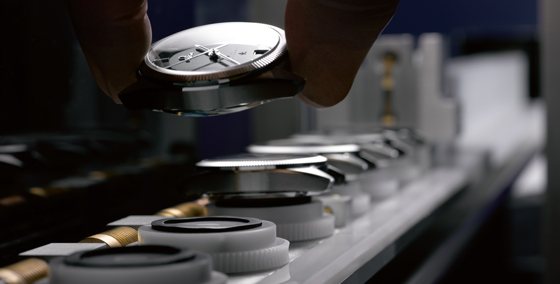
Based on a major innovation, the first Master Chronometer timepiece has emerged from the Omega workshops. It is the fruit of collaboration between the Bienne based brand and METAS, the Swiss Federal Institute of Metrology.
Last January, Omega proudly announced the creation and introduction of a new certification resulting from collaboration with METAS, the Federal Institute of Metrology. On 21 October, Nick Hayek, CEO of the Swatch Group, Stephen Urquhard, President of Omega, Christian Bock, Director of METAS and Andreas Hobmeier, Vice-President Production and Purchasing at Omega, presented the new initiative and the first watch to benefit from this innovative technology, the Globemaster.
Life began for the new Globemaster in Villeret, in a recently built ultramodern production plant where 8500/8501 and 8520/8521 movements are assembled, as well as the 8900 calibre, which is capable of withstanding very high magnetic fields and is featured in this revolutionary timepiece. Occupying a floor space of around 3,000 square metres, the assembly workshop is equipped with machines developed specially for the Villeret factory. Inserted in a microchipped collar, movements at the pre-assembly stage are routed along a “motorway” during which different parts of the calibre take shape. Some intricate stages are nonetheless carried out by hand by qualified personnel. Inside this pressurized space, dust is an unwelcome guest and every precaution has been taken to keep airborne particles to a minimum. Staff working in this enormous workshop wear full body suits, special shoes and hair caps. Movements, susceptible of generating dust, are strictly limited.
Once assembled, the 8900 movements are dispatched to the offices of the Contrôle officiel suisse des chronomètres (COSC) in Saint-Imier, where they are subjected to an initial battery of tests. They are then forwarded to Omega in Bienne, to the new Master Chronometer unit. Here they undergo the terrible ordeal of 15,000 Gauss magnetic fields: two 30-second passes in two different positions. Operation of the movements is subsequently checked and, if approved, they are cleared for casing-up. It’s then the turn of the watch head to feel the force of the electromagnet specially developed for this certification (one 30-second exposure). The watches are then handled roughly in six different positions at angles of 23 and 33 degrees, in two rooms equipped with robots capable of simulating the everyday gestures to which timepieces are subjected. After each stage of the process, the functioning of the watch's head is verified. Every 24 hours, photos are taken to observe the accuracy of the watches. Finally, water-resistance tests at different pressures are carried out. On removal from the apparatus, the timepieces are placed on a tray at a temperature of 50°. If water-resistance is not guaranteed, condensation quickly appears under the crystal. Ultimately, eight separate stages will define whether or not the timepiece merits the new certification. Within the Master Chronometer unit, METAS has its own office and has access to all data. As a result, employees of the Federal Institute of Metrology can verify the quality of data for each timepiece at any time.
The first watch to benefit from this new label is the Globemaster, which has been on sale in the brand’s boutiques since the autumn. Its dial displays the words “Master Chronometer”, attesting to the fact that the timepiece has been awarded METAS certification and can withstand 15,000 Gauss. Nick Hayek made it clear at the press conference that the development costs of this new label would not be reflected in the price of the watches. Another benefit for consumers: when they purchase a watch, they also receive a card providing access, via the brand’s website, to all results obtained by their Globemaster during the test phases. This transparency builds trust, a key value which Omega is seeking to promote among consumers.
November 05, 2015


 News
News